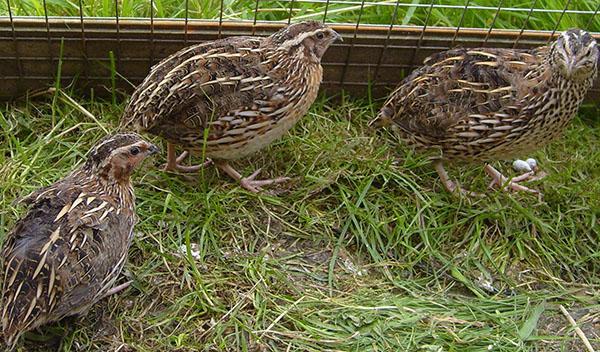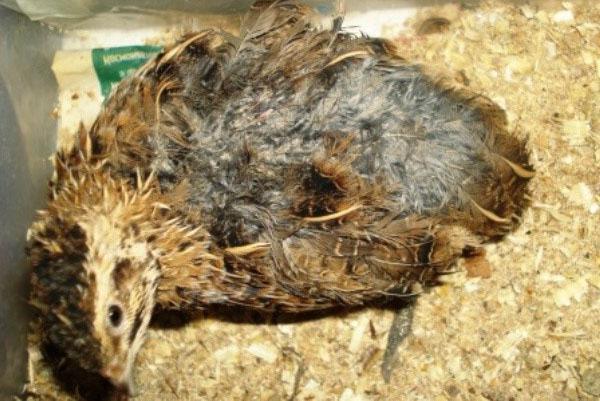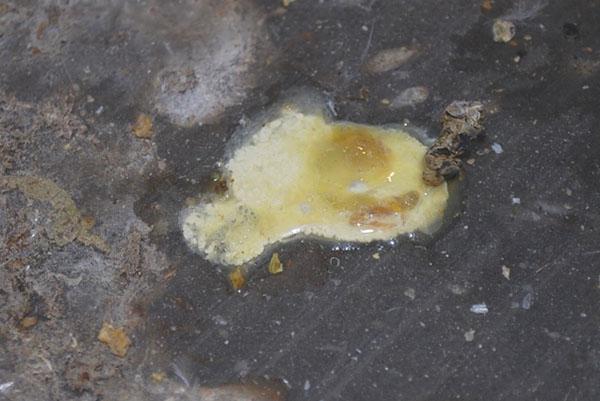Common diseases of adult quails and young stock
 Quail diseases are divided into three types: infectious, parasitic and non-infectious. Their description contains information on symptoms, methods of treatment and prevention of diseases.
Quail diseases are divided into three types: infectious, parasitic and non-infectious. Their description contains information on symptoms, methods of treatment and prevention of diseases.
Quail infectious diseases are caused by pathogenic microorganisms (bacteria, cocci, viruses) against the background of a decrease in the body's immune status and general resistance. Quail diseases occur and develop more often if vaccination is not available or the plan for its implementation is violated.
Newcastle disease (pseudo plague)

Symptomatic classification in the description of quail disease indicates two forms:
- Typical form: body temperature rises, coordination is impaired (paresis and paralysis). There is weakness, enlargement of the goiter, flow of a foul-smelling fluid from the oral cavity, bloody diarrhea.
- The atypical form affects young animals, proceeds without characteristic signs.
In the chronic course of the disease, pay attention to croaking sounds. This symptom of quail disease is characteristic of pseudo-plague.
Treatment: not developed. Due to the high contagiousness, it is impractical to treat a sick bird. They are replacing the livestock.
A pronounced paresis in Newcastle quail disease is shown in the picture.
Pullorosis
 The infection affects quail and is caused by salmonella. It is characterized by damage to the intestines, internal organs, septicemia. The morbidity is 2-6%, the mortality rate is 80%.
The infection affects quail and is caused by salmonella. It is characterized by damage to the intestines, internal organs, septicemia. The morbidity is 2-6%, the mortality rate is 80%.
The transmission factor is contaminated quail eggs - salmonella carriers.
Symptoms: The incubation period is 1-6 days. The sick young growth is weakened, stands with legs wide apart, eyes closed, breathing heavily. There is a discharge of whitish mucous feces. The fluff around the cloaca is glued together, there is a cloacal obstruction and cloacite. The young are dying.
Overheating of young animals, hypothermia, feeding of poor quality feed should be avoided - this increases susceptibility.
Treatment: impractical due to salmonella carriers. Young quail are culled. A hematological analysis of the breeding stock is performed. Premises, incubators, eggs are disinfected.
Ornithosis
 Chlamydia respiratory disease of quail. It also affects other birds. The mucous membrane of the upper respiratory tract and conjunctiva is mainly infected. Young animals are most susceptible.
Chlamydia respiratory disease of quail. It also affects other birds. The mucous membrane of the upper respiratory tract and conjunctiva is mainly infected. Young animals are most susceptible.
Symptoms: The incubation period ranges from 3 days to 3 months. The clinical picture is poorly expressed. Sick quail are drowsy, weakened, lose their appetite. Sometimes there are discharge from the nose, paralysis. The disease ends in death as a result of cachexia (wasting)
Treatment: not carried out.
A person is susceptible to psittacosis.
Aspergillosis
 Quail infectious disease caused by the fungus aspergillus. Adults suffer from a latent form.
Quail infectious disease caused by the fungus aspergillus. Adults suffer from a latent form.
Symptoms: young animals have shortness of breath, thirst, general weakness, cyanosis (blueing) of the beak and legs.
Treatment: specific. Includes antibiotic therapy, vitamin therapy, the use of antifungal drugs.
Before starting treatment, you should consult your veterinarian.
Smallpox quail
 A contagious viral disease of quail, accompanied by fever, papular-pustular rash on the head, around the eyes and on mucous membranes.
A contagious viral disease of quail, accompanied by fever, papular-pustular rash on the head, around the eyes and on mucous membranes.
Symptoms: Their manifestation depends on the state of the immune system and the skin. The eyelids and beak (a type of warty growths) are affected by pockmarks. In the oral cavity, diphtheretic overlays are found.
Treatment: feed is enriched with vitamin A. Potassium iodide is added to drinking water. Conditionally healthy birds are given preparations in the form of premixes with a set of broad-spectrum antibiotics.
Enrich the diet with vitamin A and carotene.
Quail parasitic diseases
Parasitic diseases of quail are caused by parasitic organisms (helminths, insects, protozoa).
Mallophagoz
 It develops when parasitizing on the body of a downy eater bird.
It develops when parasitizing on the body of a downy eater bird.
Symptoms: the bird is restless, constantly shaking itself off. Itching, feather loss is observed. As a result of pecking, cannibalism.
Treatment: deacarization measures are carried out: the destruction of insects on the body of the bird and in places of its keeping. Insect and acaricidal agents are used: powders, aerosols, pyrethroid solutions.
Syngamoz
 Quail nematode helminthic disease. The parasite is localized in the larynx, trachea and bronchi.
Quail nematode helminthic disease. The parasite is localized in the larynx, trachea and bronchi.
Symptoms: manifested by laryngitis, tracheobronchitis, suffocation. A sick bird has a pronounced cough with sputum, which may contain helminths.
Treatment: specific. Anthelmintics of a wide spectrum of action are successfully used.
It is recommended to carry out preventive deworming of the livestock every quarter.
"Quail blindness"
 This eye disease of quail occurs when there is a lack of vitamin A in the body. It is manifested by conjunctivitis, dry eyes, peeling around the eyes. Photophobia and blindness develop later. The eyes are often closed.
This eye disease of quail occurs when there is a lack of vitamin A in the body. It is manifested by conjunctivitis, dry eyes, peeling around the eyes. Photophobia and blindness develop later. The eyes are often closed.
Treatment: use complex vitamin preparations, premixes with the obligatory content of vitamin A. Increase the content of carotene in the diet.
Eye injury
 Observed with crowded poultry and excessive lighting conditions, which are used to increase egg production. As a result, cannibalism, pecking and eye injuries develop.
Observed with crowded poultry and excessive lighting conditions, which are used to increase egg production. As a result, cannibalism, pecking and eye injuries develop.
With traumatic eye diseases of quails and their treatment, the severity of the injuries received is taken into account. In severe cases, quails are discarded.
To avoid injury, you should adhere to bird planting standards and reduce the duration of the light period.
Internal non-communicable diseases of quail
Hypovitaminosis
 Quail disease occurs against the background of a lack of vitamins of group B, vitamins A, E, C in the bird's body.
Quail disease occurs against the background of a lack of vitamins of group B, vitamins A, E, C in the bird's body.
Symptoms: dyspeptic phenomena of the digestive system, conjunctivitis, depression, exhaustion develop. The mucous membranes are pale, the feathers are ruffled. With vitamin deficiency - death.
Treatment: replenishment of feed with vitamins. Vitamin sources: green food, legumes, feed yeast. Use ready-made quail feed, premixes.
The description of the quail disease, presented above, indicates a direct relationship between the occurrence of diseases and the age of the bird (the young are more susceptible), as well as the conditions of feeding and keeping.